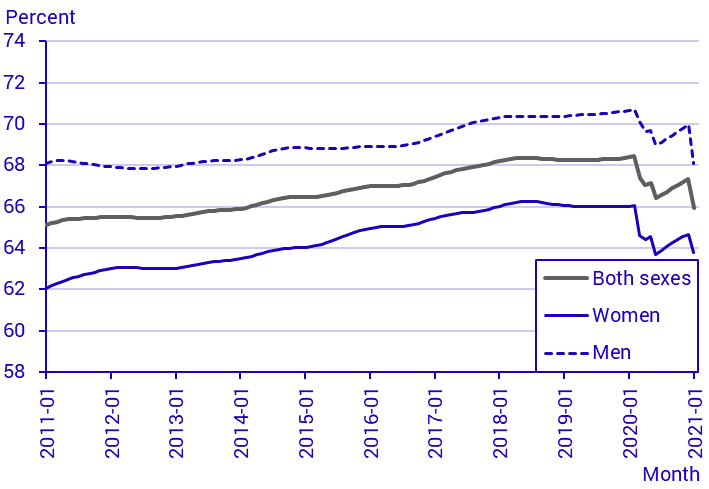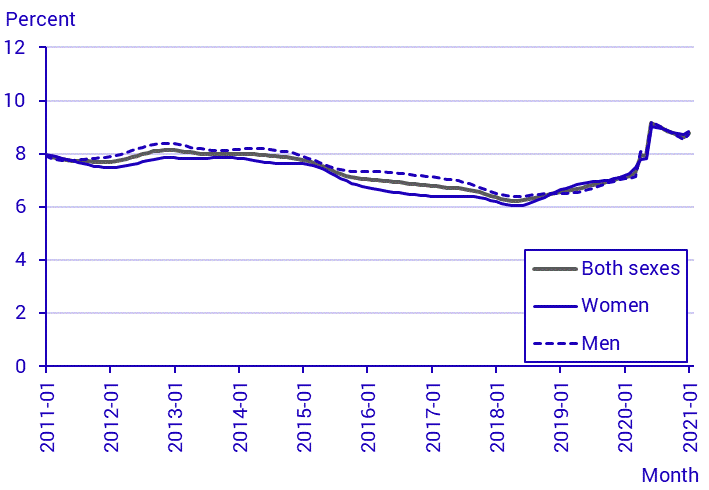Labour Force Surveys (LFS), January 2021
LFS has been adapted to new EU framework regulation on social statistics
Statistical news from Statistics Sweden 2021-06-22 9.30
As from 1 January 2021, the Swedish LFS has been amended to comply with the new EU framework regulation on social statistics, which has resulted in some changes in the survey. These changes currently lead to increased uncertainty, in particular for comparisons over time. In January 2021, there were 4 863 000 employed people. There were 498 000 unemployed people, which corresponds to an unemployment rate of 9.3 percent. The total average number of hours worked was 148.4 million hours per week. Seasonally adjusted and smoothed data showed that there were 4 958 000 employed people in January. The unemployment rate was 8.8 percent.
As from 1 January 2021, the Swedish LFS is in compliance with the new EU framework regulation on social statistics (Regulation (EU) 2019/1700 of the European Parliament and of the Council). This framework regulation has involved changes in the definition of employment, the sampling procedure, and the structure of the questionnaire. These changes may have caused breaks in the time series and therefore, this item of statistical news does not include any comparisons with the previous year for non-seasonally adjusted data. The number of employed persons decreased, partly due to the change in the definition, in which people who for certain reasons are completely absent from work for three months or more are no longer classified as being employed. Furthermore, new and updated information is used in the weighting procedures, which improves the precision in the estimates, although it also affects the levels of the number of employed persons. As from the publication concerning February 2021, comparisons with the previous month will be possible for seasonally adjusted and smoothed data. During 2021, double measurements will be made to make it possible to link data backwards in time. The aim is to make the series comparable with previous years.
Several of the seasonally adjusted series have been corrected for outliers. Thus far, it is difficult to identify what is an effect of the pandemic on the labour market and what is an effect of the new framework regulation. The changes should therefore be treated with caution. Statistics Sweden has made the assessment that the majority of the decrease in the number of employed persons between December 2020 and January is due to the change in the definition of employed persons and the new updated auxiliary information used in the estimation. The change in the definition and the new weighting procedure lead to a total estimated number of employed persons in January that is 90 000 fewer than according to the previous method.
More information on the adaptation to the framework regulation is available on the LFS product page: Information om införande av ny ramlag 2021 i AKU (Swedish)
The labour force
In January 2021, there were 5 361 000 people aged 15–74 years in the labour force, not seasonally adjusted. The number of men in the labour force was 2 830 000 and there were 2 531 000 women in the labour force. The relative labour force participation rate was 71.3 percent. Among women this rate was 68.5 percent and among men the rate was 74.0 percent.
According to seasonally adjusted and smoothed data, there were 5 435 000 people in the labour force and the labour force participation rate was 72.3 percent.
The outcome for the labour force may have been affected in part by the change in the definition of employed persons, and in part by the new information used in the weighting procedure. In addition, it is not yet clear what is an effect of the framework regulation and what is an effect of the ongoing coronavirus (COVID-19) pandemic.
Employment
In January 2021, there were 4 863 000 employed people aged 15–74 years, not seasonally adjusted. There were 2 299 000 employed women and 2 564 000 employed men. The employment rate was 64.7 percent. For women the rate was 62.2 percent, and for men the rate was 67.0 percent.
According to seasonally adjusted and smoothed data, there were 4 958 000 employed persons and the employment rate was 66.0 percent.
The number of employed persons has been affected by the change in the definition, in which some people who were absent from work are no longer classified as being employed. The new information used in the weighting procedure has also affected the outcome. In addition, it is not yet clear what is an effect of the framework regulation and what is an effect of the coronavirus (COVID-19) pandemic on the employment figures. Statistics Sweden’s assessment is that the lower level in the number of employed persons in January is mainly due to the change in the definition of employed persons and new updated auxillary information used in the estimation.
Employees
In January 2021, there were 4 368 000 employees, according to non-seasonally adjusted data. Among employees, there were 2 174 000 women and 2 194 000 men. There were 3 780 000 permanent employees and 588 000 temporary employees.
According to seasonally adjusted and smoothed data, there were 4 480 000 employees. There were 3 809 000 permanent employees and 671 000 temporary employees.
Employees are a subset of employed persons, which have been affected by a change in the definition as well as the use of new information in the weighting procedure.
Hours worked
In January 2021, the average number of hours worked was 148.4 million per week, not seasonally adjusted.
Seasonally adjusted and smoothed data showed that the total average number of hours worked per week was 147.8 million.
The number of hours worked may have been affected by the use of new information in the weighting procedure as well as by the lower level of the number of employed persons as a result of the introduction of the new definition.
At work and absence
There were 4 294 000 people employed and at work in January 2021, not seasonally adjusted.
The LFS estimates the number of people who were absent from their principal occupation for the whole week or for part of the week by main reason for absence. In January 2021, this figure was 1 695 000, not seasonally adjusted. There were 574 000 people absent for the whole week in January 2021. Among these, 134 000 were absent due to illness, while 201 000 people were absent due to holidays.
People who are absent due to lack of work or lay-offs are often absent for only part of the week. There were 65 000 people in total absent for the whole week or part of the week due to lay-offs. There were 32 000 people who stated lack of work as their main reason for absence.
Seasonally adjusted and smoothed data showed that there were 4 208 000 people at work.
As there has been a change in the definition of employed persons, in which some people who were absent from work are no longer classified as being in employment, this may have affected the number of people at work.
Unemployment
In January 2021, there were 498 000 unemployed people aged 15–74 years, which corresponds to an unemployment rate of 9.3 percent, not seasonally adjusted. There were 266 000 unemployed men, which corresponds to 9.4 percent, and 232 000 unemployed women, which corresponds to 9.2 percent.
In January, there were 477 000 unemployed persons according to seasonally adjusted and smoothed data, which corresponds to an unemployment rate of 8.8 percent.
New information is used in the estimation, which may affect the level of unemployed persons. This has led to a higher relative unemployment rate, since the labour force decreased because some people who were previously classified as being in employment are now classified as not in the labour force.
Additional questions on the impact of COVID-19 on the labour market
In view of the coronavirus (COVID-19) pandemic, questions about the impact of COVID-19 have been added to the LFS. The answers to these questions show that 74 000 employed people aged 15–74 years were absent during the whole reference week in January related to COVID-19. This means that among people who were absent during the entire reference week, 12.9 percent were absent due to COVID-19. This proportion was 13.9 percent for men and 12.0 percent for women.
Among employees aged 15–74 years who were absent during the entire reference week, 11.7 percent, which corresponds to 60 000 people, stated that their absence was related to COVID-19. This proportion was 11.8 percent for men and 11.6 percent for women. Furthermore, 15.5 percent of employees who were absent during part of the week, 158 000 people, stated that their absence was related to COVID-19. Among self-employed persons and assisting family members aged 15–74 years, 39.3 percent felt that they had less work due to the coronavirus pandemic, while 18.1 percent felt that they had more work.
To be classified as unemployed in the LFS, a person must be without a job, must be able to start work and must have sought work. This means that people who are without a job, but who have not been seeking work or are unable to start work are not classified as unemployed, but are classified, instead, as not in the labour force. In January 2021, there were 2 159 000 people aged 15–74 years not in the labour force. Among these, 81 000 people stated that they would have been able to work, but had not sought work due to COVID-19.


Next publishing will be
2021-03-18 at 9:30.
Feel free to use the facts from this statistical news but remember to state Source: Statistics Sweden.
